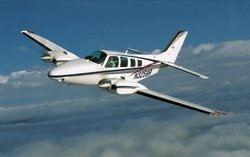Aero-Tips!
A good pilot is always learning -- how many times have you heard
this old standard throughout your flying career? There is no truer
statement in all of flying (well, with the possible exception of
"there are no old, bold pilots.")

Aero-News has called upon the expertise of Thomas P. Turner,
master CFI and all-around-good-guy, to bring our readers -- and us
-- daily tips to improve our skills as aviators. Some of them, you
may have heard before... but for each of us, there will also be
something we might never have considered before, or something that
didn't "stick" the way it should have the first time we memorized
it for the practical test.
Look for our daily Aero-Tips segments, coming each day to you
through the Aero-News Network.
Aero-Tips 09.16.06
 I was providing instruction in a
Beech Baron twin. We had climbed well above a broken-to-overcast
layer and were practicing maneuvers in the clear, blue sky above.
My student, preparing for his commercial-multiengine checkride, was
setting up for a VMC demonstration -- a maneuver showing how
control authority drops with a reduction in airspeed, until it
reaches the point a multiengine airplane can no longer maintain
directional control with one engine inoperative. Key skills in the
VMC demo are proper heading control and the correct recovery.
I was providing instruction in a
Beech Baron twin. We had climbed well above a broken-to-overcast
layer and were practicing maneuvers in the clear, blue sky above.
My student, preparing for his commercial-multiengine checkride, was
setting up for a VMC demonstration -- a maneuver showing how
control authority drops with a reduction in airspeed, until it
reaches the point a multiengine airplane can no longer maintain
directional control with one engine inoperative. Key skills in the
VMC demo are proper heading control and the correct recovery.
With the left ("critical") engine simulated "dead" and power up
on the right, I mentioned to my student that, in the extremely
unlikely event the right engine would fail for real at this point
that he would have to recover right away to avoid a dangerous
single-engine stall. Sure enough, seconds later the right engine
did die... and my student recovered wonderfully.
"How's you do that?" he asked, certain I'd somehow caused the
right engine to die. To his credit, though, my student brought the
left engine out of zero thrust (remember, we're stuck on top of a
layer of instrument conditions); once trimmed for single-engine
flight the other way he quickly processed the memory items for
engine troubleshooting. One step was to turn on the auxiliary
("boost") pump -- and the fuel-injected Continental engine roared
back to life.
He snapped the trim controls (pitch, rudder and aileron) back to
a normal, two-engine configuration, then reached up and TURNED OFF
THE BOOST PUMP. The engine immediately died. And once again my
student recovered swiftly and correctly, and once more he turned
the boost pump on.
Faced with a failed engine-driven fuel pump, I called the
training mission complete, and we got an IFR clearance to descend
into nearby Wichita. Inbound on the VOR approach my student
suddenly (and without warning) reached up and TURNED OFF the right
boost pump, causing the engine to quit once more. I quickly leaned
over and turned it back on before he had a chance to trim off the
pressures, but he was well on his way.
Breaking out and entering downwind for landing, he once again
jerked his hand up and TURNED OFF THE BOOST PUMP. I tried to beat
him to the switch but didn't quite make it; I did snap it on right
away, before the engine even completely sputtered out of fuel. But
I'd learned my lesson; when he again reached up on short final to
turn off the boost pump I was guarding the switch with my hand.
We debriefed, and I learned that he had flown most of his
multiengine time in a Piper Apache, which calls for boost pumps to
be OFF after engine restarts, and ON for approaches and for
landings. When first checking out in his Baron my student learned
the boost pumps should be OFF for approaches and landings, and had
programmed his response to turn the boost pump OFF as part of a
mental checklist for various phases of flight. He was so
indoctrinated he didn't even consider there are times you NEED the
boost pump on, when the engine-drive pump had died. He was so fast
acting on his knowledge that he didn't take the time to consider
unusual circumstances.
The impulsive pilot
The FAA calls impulsivity an attitude to do something, anything,
quickly, and to do the first thing that comes to mind. An important
and positive trait for a well-trained pilot in the early stages of
an emergency, impulsivity can be hazardous in most cases, when time
exists to think before acting and to perform things correctly.
Aero-tip of the day: Manage impulsivity-be
ready to react quickly in the rare case when it's necessary, but
take your time and correctly respond to status when you have
time.
 ANN's Daily Aero-Linx (04.15.24)
ANN's Daily Aero-Linx (04.15.24) Classic Aero-TV: 'No Other Options' -- The Israeli Air Force's Danny Shapira
Classic Aero-TV: 'No Other Options' -- The Israeli Air Force's Danny Shapira Aero-News: Quote of the Day (04.15.24)
Aero-News: Quote of the Day (04.15.24) Airborne 04.16.24: RV Update, Affordable Flying Expo, Diamond Lil
Airborne 04.16.24: RV Update, Affordable Flying Expo, Diamond Lil ANN's Daily Aero-Term (04.16.24): Chart Supplement US
ANN's Daily Aero-Term (04.16.24): Chart Supplement US




